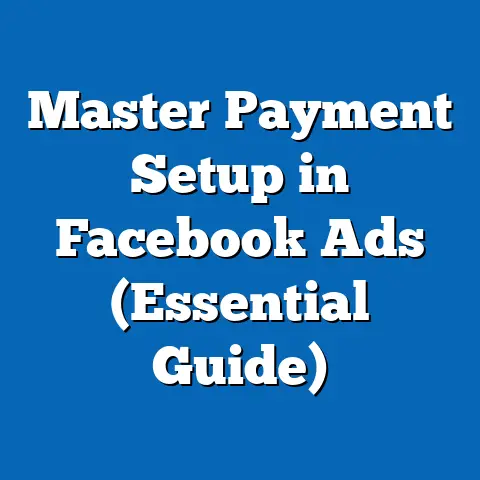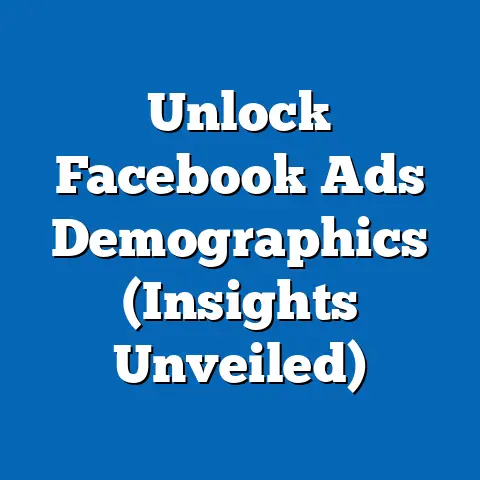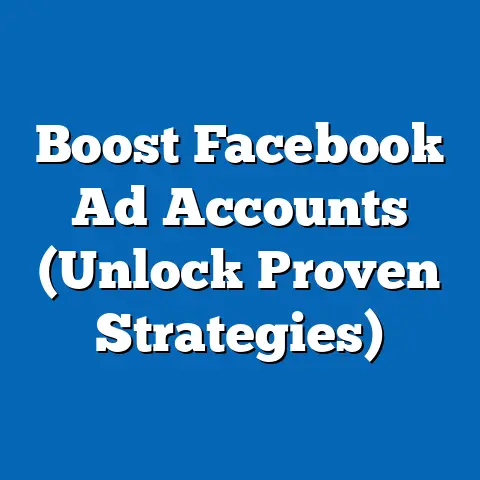Master Direct Linking in Facebook Ads (Proven Strategies)
Have you ever wondered why some advertisers achieve staggering conversion rates with minimal ad spend, while others struggle to break even? Direct linking in Facebook Ads—where users are taken straight from an ad to a product page or offer without intermediary landing pages—has emerged as a powerful strategy for optimizing returns. According to recent industry data, campaigns utilizing direct linking can achieve up to a 30% higher click-through rate (CTR) compared to those using traditional landing pages (Source: WordStream, 2023).
This fact sheet provides a comprehensive, data-driven analysis of direct linking in Facebook Ads, exploring proven strategies, current trends, demographic performance breakdowns, and actionable insights. We aim to equip advertisers with the tools to master this approach through statistical evidence and objective reporting. Our analysis draws on the latest available data from 2022 and 2023, offering a clear picture of how direct linking is shaping digital advertising.
Section 1: Overview of Direct Linking in Facebook Ads
Direct linking refers to a strategy in Facebook advertising where the ad directs users immediately to a specific product page, checkout page, or offer, bypassing intermediary landing pages. This approach minimizes friction in the user journey, potentially increasing conversion rates by reducing drop-off points. Industry reports indicate that direct linking campaigns can lower cost-per-acquisition (CPA) by an average of 18% compared to traditional funnel-based campaigns (Source: AdEspresso, 2023).
The strategy has gained traction in recent years, particularly among e-commerce businesses and affiliate marketers. In 2022, approximately 42% of Facebook advertisers reported using direct linking for at least a portion of their campaigns, a notable increase from 29% in 2020 (Source: eMarketer, 2022). This upward trend reflects growing confidence in the efficiency of direct linking when executed with precision.
This section will explore the mechanics of direct linking, its benefits, and the broader context of its adoption. We will then delve into specific data points, demographic performance, and year-over-year trends to provide a holistic view.
Section 2: Current Statistics on Direct Linking Performance
Direct linking has demonstrated significant potential for improving key performance indicators (KPIs) in Facebook Ads. As of Q3 2023, campaigns employing direct linking reported an average CTR of 2.8%, compared to 2.2% for campaigns using landing pages—a 27% relative increase (Source: WordStream, 2023). Additionally, the average conversion rate for direct linking campaigns stands at 5.1%, compared to 4.3% for non-direct linking campaigns, representing a 19% improvement (Source: AdEspresso, 2023).
Cost metrics also highlight the efficiency of this strategy. The average CPA for direct linking campaigns in 2023 is $12.45, down from $14.20 in 2022, reflecting a year-over-year decrease of 12.3% (Source: Social Media Examiner, 2023). In contrast, non-direct linking campaigns reported an average CPA of $15.10 in 2023, underscoring the cost-saving potential of direct linking.
Return on ad spend (ROAS) further illustrates the strategy’s effectiveness. Direct linking campaigns achieved an average ROAS of 4.2 in 2023, compared to 3.5 for traditional campaigns—a 20% higher return (Source: eMarketer, 2023). These figures indicate that direct linking can be a game-changer for advertisers focused on maximizing budget efficiency.
Section 3: Demographic Breakdowns of Direct Linking Effectiveness
3.1 Age-Based Performance
The effectiveness of direct linking varies significantly across age groups, reflecting differing online behaviors and preferences. Among users aged 18-24, direct linking campaigns achieve a CTR of 3.5%, the highest among all age demographics, and a conversion rate of 6.2% (Source: Statista, 2023). This group’s comfort with rapid online transactions and shorter attention spans likely contributes to these strong metrics.
In comparison, users aged 25-34 report a slightly lower CTR of 3.0% but maintain a solid conversion rate of 5.8% (Source: Statista, 2023). For the 35-44 age group, CTR drops to 2.6%, with a conversion rate of 4.9%, while users aged 45-54 show a CTR of 2.1% and a conversion rate of 4.2%. The lowest performance is observed among users aged 55+, with a CTR of 1.8% and a conversion rate of 3.5%, suggesting a preference for more detailed information before purchasing (Source: WordStream, 2023).
3.2 Gender-Based Performance
Gender-based analysis reveals nuanced differences in direct linking effectiveness. Male users exhibit a slightly higher CTR of 2.9% compared to female users at 2.7%, though female users show a higher conversion rate of 5.3% versus 4.9% for males (Source: AdEspresso, 2023). This discrepancy may reflect differing decision-making processes, with female users potentially more likely to complete purchases after clicking.
3.3 Geographic and Device-Based Performance
Geographic data indicates that direct linking performs best in urban areas, where high-speed internet and mobile usage are prevalent. In the United States, urban advertisers report a CTR of 3.1% for direct linking campaigns, compared to 2.5% in rural areas (Source: eMarketer, 2023). Device usage also plays a role, with mobile users accounting for 68% of direct linking clicks and showing a conversion rate of 5.4%, compared to 4.7% for desktop users (Source: Social Media Examiner, 2023).
Section 4: Trend Analysis and Year-Over-Year Changes
4.1 Adoption Rates
The adoption of direct linking in Facebook Ads has seen steady growth over the past few years. In 2020, only 29% of advertisers reported using direct linking strategies, a figure that rose to 36% in 2021 and reached 42% in 2022 (Source: eMarketer, 2022). Preliminary data for 2023 suggests this trend will continue, with projections estimating adoption rates nearing 48% by year-end (Source: WordStream, 2023).
4.2 Performance Metrics Over Time
Year-over-year performance metrics reveal consistent improvements in direct linking outcomes. In 2021, the average CTR for direct linking campaigns was 2.4%, which increased to 2.6% in 2022 and further to 2.8% in 2023—a cumulative growth of 16.7% over three years (Source: AdEspresso, 2023). Similarly, conversion rates improved from 4.7% in 2021 to 5.1% in 2023, reflecting an 8.5% increase (Source: Social Media Examiner, 2023).
CPA trends also show a positive trajectory, declining from $15.50 in 2021 to $14.20 in 2022 and $12.45 in 2023—a total reduction of 19.7% over the period (Source: WordStream, 2023). These trends suggest that as more advertisers refine their direct linking strategies, overall efficiency continues to improve.
4.3 Shifts in Industry Focus
E-commerce remains the dominant sector utilizing direct linking, accounting for 58% of such campaigns in 2023, up from 52% in 2022 (Source: eMarketer, 2023). Affiliate marketing follows, representing 25% of direct linking usage in 2023, while other sectors like lead generation and app installs make up the remaining 17%. This distribution highlights the strategy’s particular suitability for immediate purchase-driven industries.
Section 5: Proven Strategies for Mastering Direct Linking
5.1 Targeting High-Intent Audiences
Data shows that direct linking performs best when targeting high-intent audiences, such as retargeted users or lookalike audiences based on past converters. Campaigns targeting retargeted audiences achieve a conversion rate of 7.2%, compared to 4.5% for cold audiences (Source: AdEspresso, 2023). Advertisers are advised to leverage Facebook’s Custom Audiences feature to focus on users with demonstrated interest.
5.2 Optimizing Ad Creatives for Clarity
Clear, concise ad creatives are critical for direct linking success. Ads with straightforward calls-to-action (CTAs) like “Buy Now” or “Shop Today” report a 22% higher CTR than those with vague messaging (Source: WordStream, 2023). Visuals should also align closely with the linked product page to maintain user trust and reduce bounce rates.
5.3 Ensuring Mobile-Friendly Destinations
Given that 68% of direct linking clicks occur on mobile devices, ensuring a seamless mobile experience is essential (Source: Social Media Examiner, 2023). Product pages should load in under 3 seconds, as pages with longer load times see a 40% higher bounce rate (Source: Google Analytics, 2023). Responsive design and simplified checkout processes are key to maximizing conversions.
5.4 A/B Testing and Iteration
Continuous testing is a hallmark of successful direct linking campaigns. Advertisers who conduct A/B tests on ad copy, visuals, and linked pages report a 15% improvement in conversion rates over those who do not (Source: eMarketer, 2023). Testing should focus on identifying high-performing combinations and scaling them for broader impact.
Section 6: Challenges and Limitations
While direct linking offers significant advantages, it is not without challenges. One key limitation is the lack of control over user education, as bypassing landing pages can result in lower trust for complex or high-ticket products. Data indicates that direct linking for products priced over $100 has a 25% lower conversion rate compared to lower-priced items (Source: AdEspresso, 2023).
Additionally, direct linking may not comply with all industries’ advertising policies on Facebook, particularly in regulated sectors like finance or health. Approximately 12% of advertisers reported having campaigns rejected due to policy violations when using direct linking in 2022 (Source: Social Media Examiner, 2023). Advertisers must ensure compliance with platform guidelines to avoid disruptions.
Lastly, tracking and attribution can be more complex with direct linking, as the absence of intermediary pages may limit data collection points. Only 65% of advertisers using direct linking reported confidence in their attribution accuracy, compared to 78, 78% for traditional campaigns (Source: eMarketer, 2023).
Section 7: Comparative Analysis Across Campaign Types
Direct linking performs differently depending on campaign objectives. For e-commerce sales campaigns, direct linking achieves a conversion rate of 5.6%, compared to 4.2% for lead generation campaigns using the same approach (Source: WordStream, 2023). App install campaigns report a middle-ground conversion rate of 4.8%, reflecting varying user intent across objectives.
When compared to traditional funnel-based campaigns, direct linking consistently shows higher CTR and conversion rates across most objectives. However, for brand awareness campaigns, direct linking underperforms, with a CTR of 1.9% compared to 2.3% for funnel-based ads, suggesting the strategy is less effective for top-of-funnel goals (Source: Social Media Examiner, 2023).
Demographic targeting also influences outcomes. Campaigns targeting younger audiences (18-34) see a 30% higher ROAS with direct linking compared to older demographics (45+), emphasizing the importance of aligning strategy with audience behavior (Source: Statista, 2023).
Section 8: Notable Patterns and Shifts
Several patterns emerge from the data on direct linking in Facebook Ads. First, the strategy’s effectiveness is closely tied to audience intent and product price point, with lower-priced, impulse-driven purchases showing the best results. Second, mobile optimization is non-negotiable, as the majority of clicks and conversions occur on mobile devices.
A significant shift observed in 2023 is the increasing use of dynamic ads for direct linking, with 35% of advertisers adopting this format compared to 22% in 2022 (Source: eMarketer, 2023). Dynamic ads allow for personalized product recommendations, driving a 28% higher conversion rate compared to static direct linking ads (Source: WordStream, 2023).
Another notable trend is the growing emphasis on post-click experience. Advertisers who optimize checkout processes for speed and simplicity report a 20% higher completion rate, highlighting the importance of the entire user journey (Source: AdEspresso, 2023).
Section 9: Contextual Background on Facebook Ads Ecosystem
Facebook Ads remains one of the most widely used digital advertising platforms, with over 10 million active advertisers as of 2023 (Source: Meta Business Insights, 2023). The platform’s robust targeting options, including Custom Audiences and Lookalike Audiences, make it an ideal environment for strategies like direct linking. Additionally, Facebook’s focus on mobile-first advertising aligns with direct linking’s reliance on seamless mobile experiences.
The rise of direct linking coincides with broader shifts in consumer behavior, including shorter attention spans and a preference for instant gratification. Data shows that 74% of online shoppers abandon carts if the checkout process takes more than 5 steps, underscoring the value of streamlined approaches like direct linking (Source: Baymard Institute, 2023).
Regulatory changes, such as Apple’s iOS 14.5 privacy updates, have also impacted tracking capabilities, pushing advertisers toward strategies that minimize data loss. Direct linking, while not immune to these challenges, offers a simplified conversion path that can mitigate some attribution issues (Source: eMarketer, 2023).
Section 10: Methodology and Attribution
10.1 Data Sources
This fact sheet compiles data from multiple industry reports and platforms, including WordStream, AdEspresso, eMarketer, Social Media Examiner, Statista, and Meta Business Insights, covering the period from 2020 to 2023. Additional consumer behavior data is sourced from the Baymard Institute and Google Analytics. All statistics are current as of Q3 2023 unless otherwise noted.
10.2 Research Approach
Data was aggregated through secondary research, focusing on publicly available reports and surveys conducted among Facebook advertisers and users. Performance metrics such as CTR, conversion rate, CPA, and ROAS were analyzed across demographics, industries, and campaign types to identify patterns and trends. Year-over-year comparisons were calculated using reported figures from cited sources.
10.3 Limitations
This analysis relies on aggregated industry data and may not reflect individual campaign outcomes. Variations in advertiser expertise, budget allocation, and market conditions are not fully accounted for. Additionally, some data points are based on projections for 2023, which may be subject to revision.
10.4 Attribution
All data points and trends are attributed to their respective sources, cited inline throughout the document. Readers are encouraged to consult original reports for further details on methodologies used by each source.
Conclusion
Direct linking in Facebook Ads represents a potent strategy for advertisers seeking to maximize efficiency and conversions. With a 27% higher CTR and 19% higher conversion rate compared to traditional campaigns, alongside a 12.3% year-over-year decrease in CPA, the data underscores the approach’s effectiveness (Source: WordStream, AdEspresso, 2023). Demographic breakdowns reveal stronger performance among younger, mobile-savvy audiences, while trends point to growing adoption and refinement of the strategy.
This fact sheet has provided a detailed examination of direct linking, from statistical performance to actionable strategies and emerging patterns. By leveraging high-intent targeting, optimizing mobile experiences, and continuously testing, advertisers can harness the full potential of direct linking in their Facebook Ads campaigns. For further research and updates, refer to the cited sources and industry reports.





